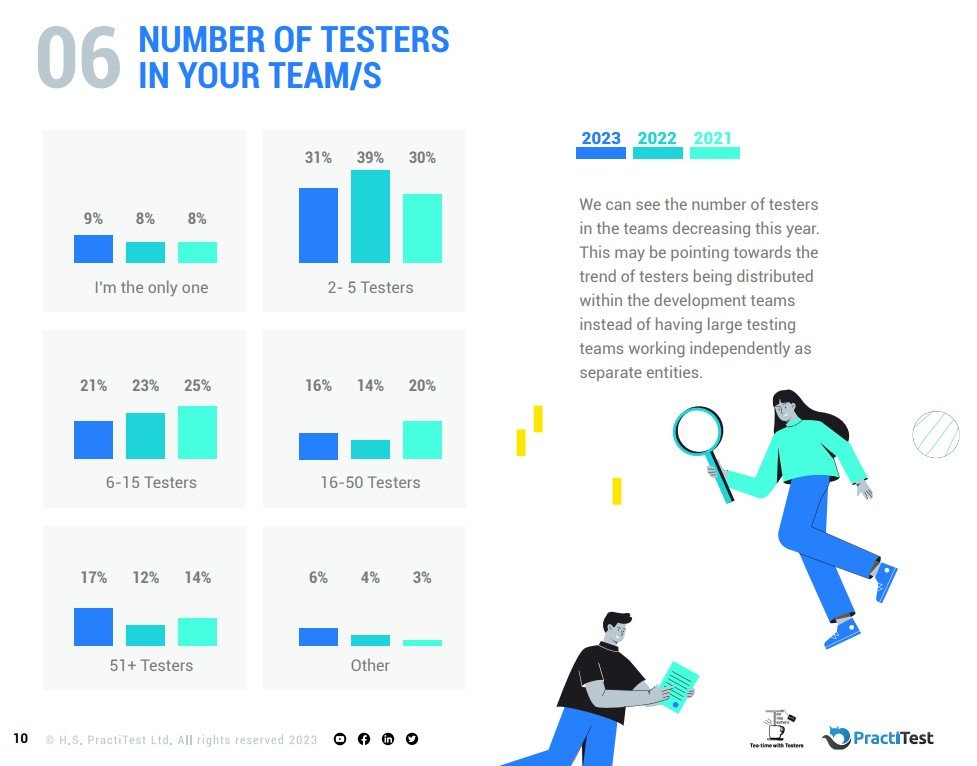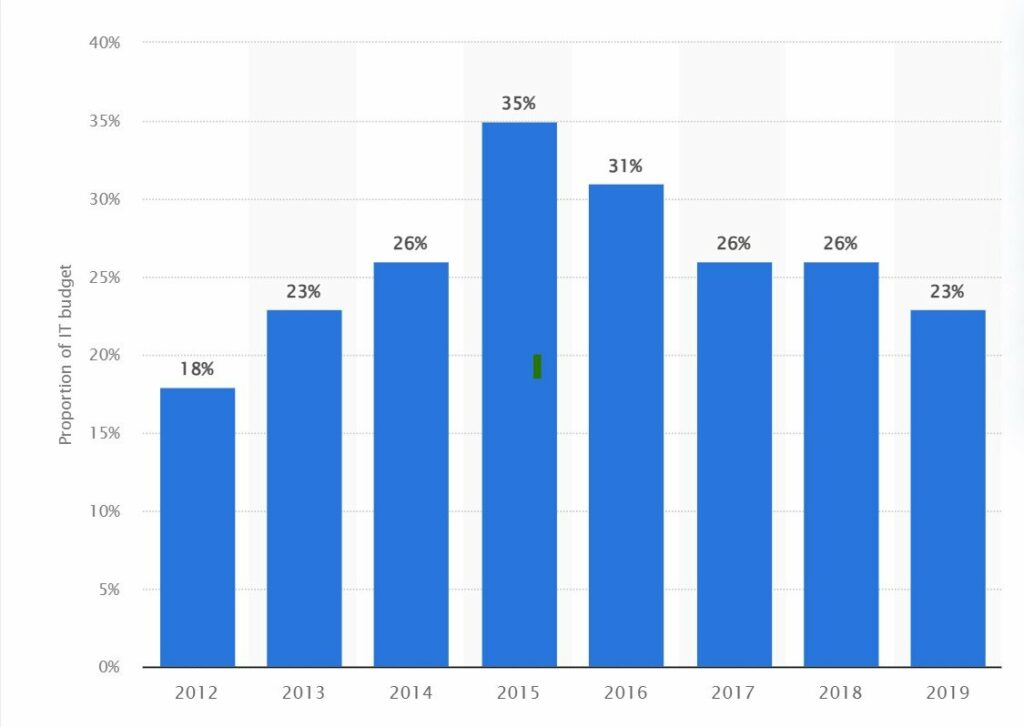Building Quality Assurance Team: Everything You Need to Know
In this article, we will discuss every factor related to building a winning quality assurance team, like what they do, what are the roles of in QA team and could be an Ideal QA team structure, how much does it cost, and more.

How much of your software testing is done by dedicated QA testers? 30%, 10%, or less? If so, then you are not the only one. A survey conducted by Practitest in 2023 revealed that in one-third of companies, less than 10% of tests are performed by dedicated QA testers.
In 2021, a software bug in the New Jersey hospital’s vaccine scheduling system led to thousands of duplicate appointments. Can you imagine what a critical threat it is? Not just that, Tesla had to recall its 135,000 vehicles due to a memory error. Perhaps these can be avoided with proper testing.
Perhaps, you can avoid unwanted post-production costs with proper planning and integrated testing from the planning phase. That is where your software quality assurance team provides value.
There is a myth in the industry that “the tester’s only job is to find bugs”. Well, having a test team on board can also help you plan properly and create delicate software solutions.
Another misconception is that “testing is time-consuming and expensive,” but by going the right way, you can set up a software QA team that doesn’t kill time or cost too much.
Let’s discuss!
What is A Software Quality Assurance (SQA)?
Before we dive deep into the delicate matters of building a QA team, let’s get to know what quality assurance really is.
Quality assurance (QA) is the process of developing and maintaining standards for products. The team assigned with the task of quality assurance is called the QA team.
QA team ensures consistency in the quality of products, boosting brand reputation. Businesses see workflow improvements by standardizing practices.
For software development, QA includes creating metrics, running simulations, testing software functions, and inspecting code and design.
Responsibilities of a QA Team
Your software QA monitors each phase of the software development process to deliver your software to its users successfully. That’s why your responsibilities include a wide range of crucial tasks. These are the responsibilities of the software quality assurance team.
- Make detailed test plans with testing strategies, goals, and methods according to your project’s needs.
- Create and execute test cases and scenarios, both manually and automated testing methods, to simulate real-world usage.
- Identify bugs, glitches, and errors that could affect performance.
- Log and document identified issues and track their status.
- Retest software after changes to check for new issues after updates or fixes.
- Work with developers, project managers, clients, and other stakeholders to fix testing errors.
- Develop and maintain automated test scripts to help make repetitious testing processes easier.
Your QA also has some additional responsibilities, such as Performance Testing (including load and stress), Security Testing, Usability Testing, Compatibility Testing, Requirements Analysis, etc.
When do you need a QA Team?
Generally, most projects will hire their QA team near the end, when the software is almost fully functional, and the project is in the testing process. Basic SDLC also approves this, but if you look closely, it increases the risk, cost, and timeline of any project.
On the other hand, if QA is involved early, they can discover the issues early, and the developers can fix them. This way, when it comes time to test the final product, there will be fewer problems and risks to solve, which will reduce the risk, cost, and timeline of your project.
Building a Software Quality Assurance Team
Determined to build your software quality assurance team? Let’s get to know things that are fundamental in building one, like the size of your team, main roles, structure, and cost.
Determining the Optimal Size for Your SQA Team
The first thing you need to figure out is how many people you need to hire to establish the SQA team. Well, the size of the quality control team can vary depending on several factors, such as the project complexity, timeline, and budget.
As a general guideline, your SQA team needs to be 25% to 33% of your development team.
Say you have a development team of 20 people; here are some approximate SQA team size recommendations based on this guideline:
a) Minimum SQA Team Size (25% of Development Team):
20 developers x 25% = 5 SQA team members.
b) Moderate SQA Team Size (30% of Development Team):
20 developers x 30% = 6 SQA team members.
c) Larger SQA Team Size (33% of Development Team):
20 developers x 33% = 7 SQA team members.
It doesn’t mean that you need to establish one team of 5 or 7 people. In fact, in recent times, testers are distributed among the development team to work alongside developers from the beginning of the project. This trend is reflected in the practice research we mentioned above.

Important Roles in a QA Team
Now it’s time to know the professionals you want in your team. Just like the team size, the QA team’s role depends on various factors like project size, complexity, budget, resource, timeline, etc. In this section, I will discuss the most common ones.
Let’s have a quick look at the QA team roles.
| Role | Plan and document the testing process |
| QA Manager | Guides the entire QA process and strategy |
| QA team lead | Supervises and coordinates your QA team |
| QA Engineer | Tests software and identifies bugs |
| Test Analyst | Plan and documents the testing process |
| Test Architect | Develops the architecture and framework for your software product |
QA Manager
Your QA manager guides the entire QA process and strategy. He/she is kind of backbone of your QA team. From defining the quality standards to monitoring the performance of the QA team, his/her job covers everything. He/she also coordinates with other professionals (such as developers, project managers, business analysts, etc.) to ensure that the software meets the client’s expectations and requirements.
QA team lead
The person in charge of your team’s supervision and coordination is your QA team lead. He/she ensures the testing is done efficiently and within the project timeline and budget. Also, communicating with the software development team and the client to provide updates and feedback on the software quality is his/her duty. He/she also takes care of risk and defect management.
QA Engineer
Your QA engineer is responsible for creating detailed test plans, developing test cases, executing various testing methods, and identifying bugs using multiple tests (such as functional, performance, usability, security, etc.) He/she may also automate some tests using tools and frameworks or perform manual testing by following test cases and scenarios.
Test Analyst
Supporting your QA engineer by planning and documenting the testing process is your Test Analyst’s responsibility. He/she also reviews the software requirements and design to determine the features and functionalities that need to be tested. Writing test cases, scripts, and reports to track the testing progress and outcome is also part of your Test Analyst’s job.
Test Architect
Your test architect designs and develops the test architecture and framework for your software product. He/she selects the appropriate tools and technologies for testing and ensures that they are integrated with the software development environment. Also provides guidance and best practices to the QA team on how to implement effective testing.
QA Team Structure
A small but well-structured team can do more than bigger unstructured teams. Studies have also shown that a well-planned team structure can positively impact the outcome. So, it’s important to figure out the ideal team structure for your SQA team as well.
So what are the options you have when you define the team structure? Let’s discuss the prominent ones.
1. Hierarchical QA Team Structure
It is one of the most used team structures due to its simple nature.
In the hierarchy of the QA team, the first person we can put is your QA Manager as a high-level executive. Then your Team lead and Test architect both work directly under your QA Manager and guide the team and test process.

Your QA engineer and Test Analyst report to your Team Lead. You can have multiple QA engineers, Test Analysts, and Team Leads based on your team size.
Advantages
- Clear reporting structure.
- Defined roles and responsibilities.
- Centralized management.
Considerations
- Potential for bottlenecks in management.
- Hierarchical structures may not fit well with agile methodologies.
2. Matrix SQA Team Structure
The matrix team structure is applied when you have multiple projects and the QA team needs to handle them all at once.
Here are the key team members in the matrix team structure:
QA Manager: Provides strategic direction and high-level coordination.
Test Leads: Lead testing efforts for specific projects.QA Engineers: Collaborate on multiple projects, reporting to both test leads and project managers.
Advantages
- Greater flexibility for QA engineers to work on different projects.
- Improved collaboration between QA and project teams.
Considerations
- Potential for role confusion.
- Complex reporting relationships.
Agile/Scrum SQA Team Structure
Applicable when your development team follows agile methodology. QA engineers work closely with developers in agile teams, participating in sprint planning, daily stand-ups, and sprint reviews.
Key Members in a agile SQA team
QA engineers: QA engineers are embedded within agile development teams.
Scrum Master: Facilitates agile processes and collaboration.
Advantages
- Close collaboration between QA and development teams.
- Faster issue resolution.
- Enhanced communication.
Considerations
- Requires QA engineers to have strong interpersonal skills.
- May not be suitable for non-agile projects.
Cross-Functional SQA Team Structure
QA professionals from Cross-Functional QA Squads work alongside developers, designers, and other specialists in cross-functional teams focused on specific features or modules.
Advantages
- In-depth expertise in specific project areas.
- Faster feedback and issue resolution.
- High collaboration.
Considerations
- Requires strong collaboration and communication skills.
- May require adjustments for resource allocation.
Cost of Establishing SQA Team
Last but not least, how much should you spend on building your QA team? Before we discuss this further, let’s have a look at a statistica report on the percentage of expenditure for quality assurance.

As you can see, the proportion of the QA budget is around 20% of the total development budget, so do you need to spend that much?
No, the expenditure on QA actually depends on many things, like your team structure, composition, locality, experience needed, and many more.
To determine how much to spend on QA testing, follow The 10% Rule. This rule suggests allocating approximately 10% of the development budget to QA testing for most mid-sized projects. However, this calculation only considers expenses related to development or “engineering” and not other expenses like marketing or legal.
But what is the cost of hiring QA professionals? As I mentioned previously, the rate varies based on location and experience. For example, if you build an in-house team, you need to pay around $135/hour, and if you outsource your QA team to Bangladesh, hiring a QA engineer will cost you around $30 an hour. To get a basic idea of the cost of hiring QA, have a look at this table.
| Role | Hourly Rate (If you hire in-house in the USA) | Hourly Rate (If you outsource to Bangladesh) |
| QA Manager | $65 to $86 | $35 to $50 |
| QA team lead | ~$62 | $30 to $40 |
| QA Engineer | ~$45 | $25 to $35 |
| Test Analyst | $42 to $58 | $25 to $35 |
| Test Architect | $82 to $99 | $30 to $45 |






